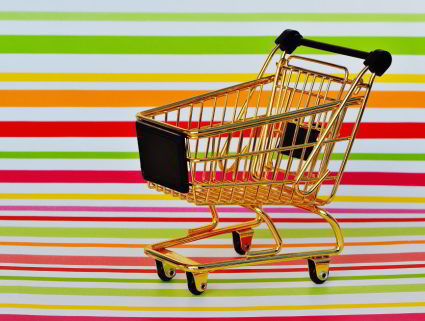Cart abandonment occurs when a customer adds items to their online shopping cart, but ends the session without completing their purchase.
This a common issue – more than half of shopping carts are abandoned, according to our research.
With stats like that, it’s easy to feel powerless. What can you do about it if a shopper decides to give up on their purchase?
In reality, many customers simply get distracted, or use the cart as a reminder for later. That means it’s well within your power to recover revenue from these visitors.
Here, we’ll cover seven methods to tackle cart abandonment.
We’ll start with how to reduce shopping abandonment in the first place. Then, we’ll explore proven tactics to win back customers – including our favorite examples from across the web.
1. Incorporate trust signals and social proof
To buy a product online requires a lot of trust. To make a transaction, a customer will likely have to share with you their email address, bank details, and their hard-earned cash.
If you don’t instill trust from the beginning of the buying process, shoppers may not feel confident enough to complete a purchase.
Research from Trustpilot shows that 86% of consumers are more likely to make a purchase when they see star ratings and reviews on the homepage. Ratings and reviews on a product detail page are the second most impactful, influencing 85% of consumers.
By including these trust signals throughout the customer journey, you can reduce purchase hesitation and decrease the number of abandoned carts.
Tap Warehouse uses social proof messaging on both the homepage and the product page. When customers reach the cart, they already feel confident in the product and service.
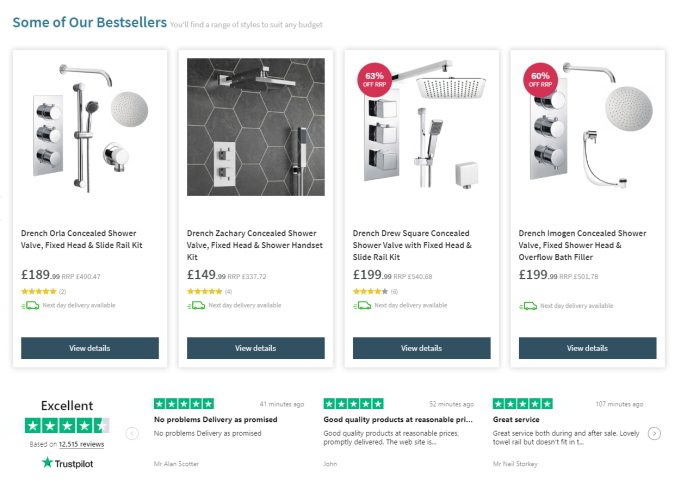 |
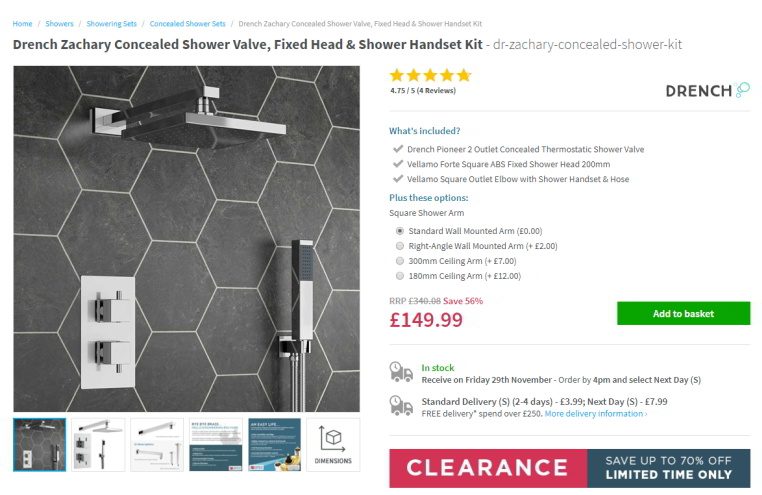 |
2. Tell shoppers exactly what they’re getting
Shopping online without access to a tangible product means that consumers require a good level of detail before they can commit to making a purchase. That’s why 43 percent of shoppers prefer to physically try products in-store before buying.
Where online shopping is concerned, you need to give customers enough information to make an informed decision.
On the product page, that includes:
- A good quality product image
- The name of the product
- Technical specifications
- Available sizes and colors
- Shipping and returns options
Real-time content can be added to increase trust and build excitement. For instance, product star ratings, popularity messaging and countdown timers.
This product detail page from Glasses Direct leverages customer ratings and popularity messaging to supplement product details.
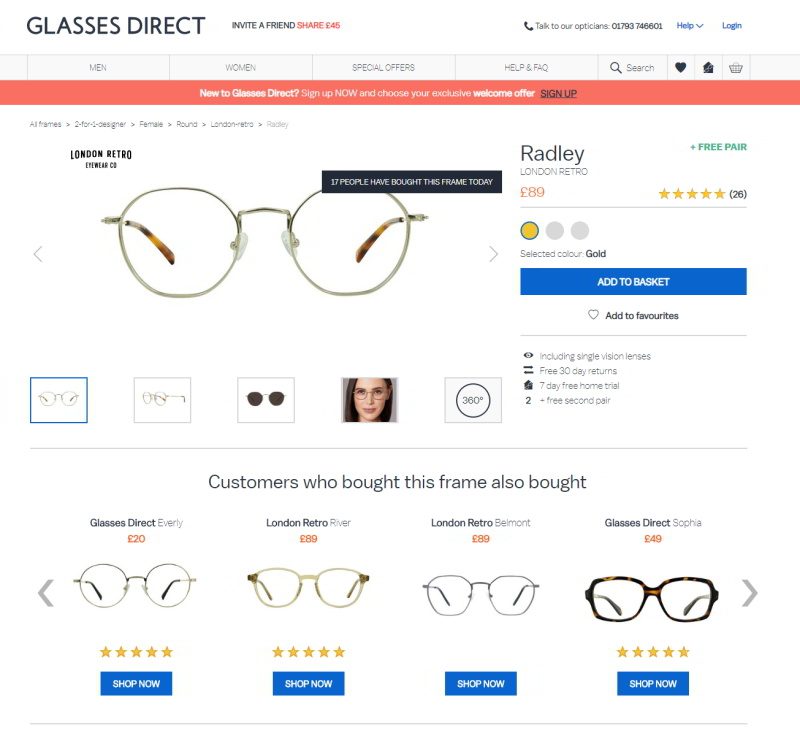
On cart and checkout pages, it should be easy for the consumer to review what they’re buying.
Don’t leave shoppers in the dark about delivery, returns and payment options. At this stage, customers are probably confident about your products, but they may be less confident in the online shopping process.
Make it clear that:
- Customer’s money will be protected in a secure transaction.
- They can expect delivery within a given timeframe.
- They can return products that aren’t quite right.
Fashion giant ASOS provides clear details and reassurance at every stage of the cart and checkout process:
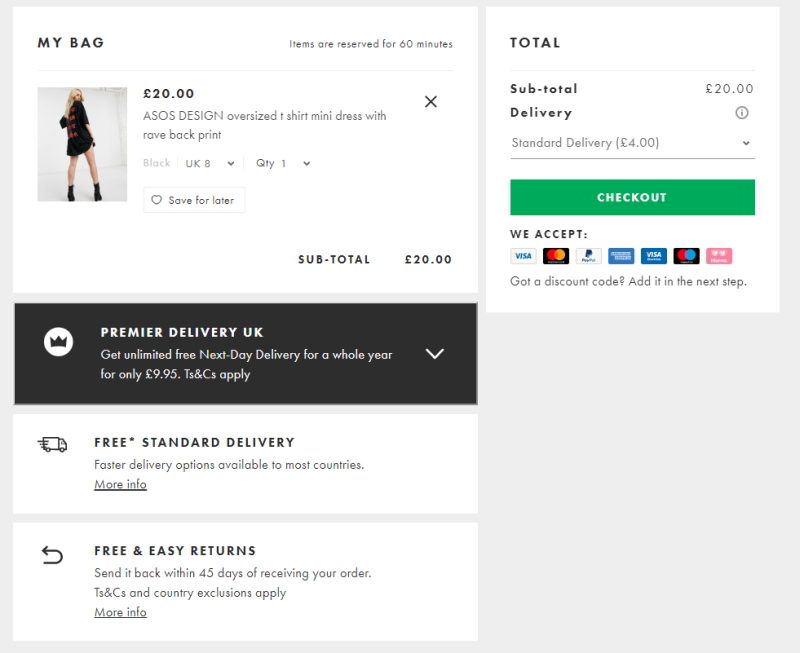 |
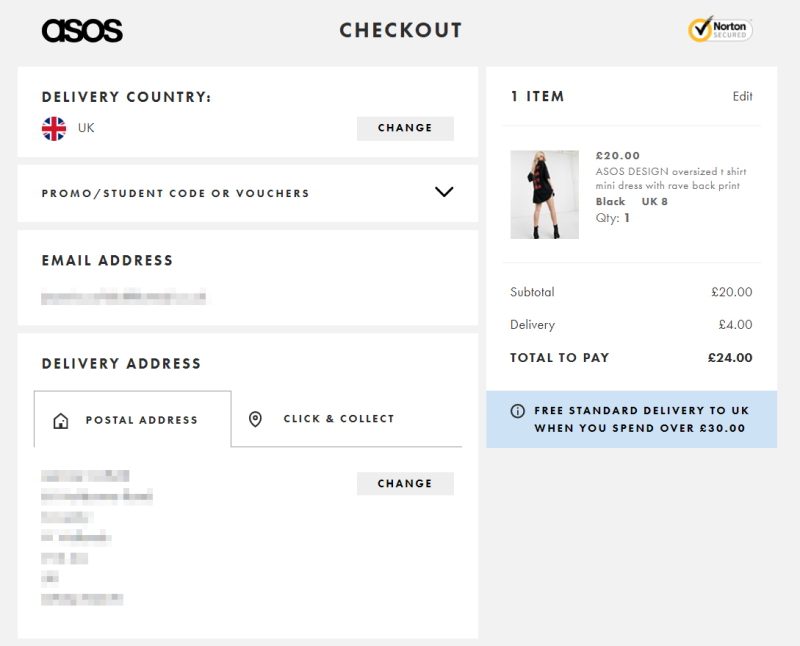 |
3. Win back distracted shoppers with exit intent popovers
Many customers will put an item in their cart for later, then continue shopping and get distracted.
You can use an exit intent popover to win these shoppers back before they leave the website.
An exit intent popover is triggered when a shopper moves their cursor to exit the webpage. On mobile, the overlay is triggered when someone starts to switch between tabs, or presses the browser back button.
These popovers can’t push a visitor away from your website (they’re already leaving), but might remind them to stay and complete a purchase.
Monica Vinader serves this popover when a visitor starts to leave the website with items still in their cart. The shopper sees an image of the product to remind them what they wanted, and additional information to reduce purchase anxiety.
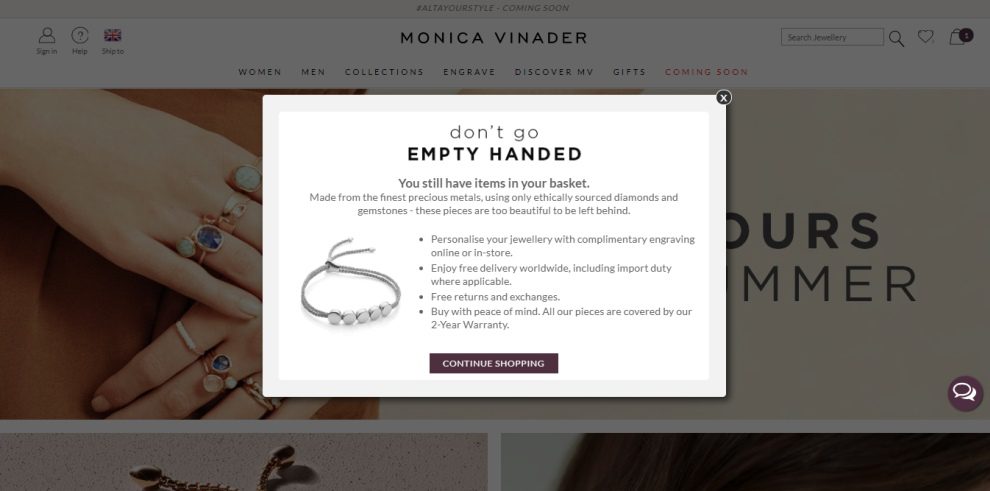
It’s good practice to offer the customer a reminder email in case they aren’t able to complete the purchase right away. Here’s a great example from Feel Good Contacts:
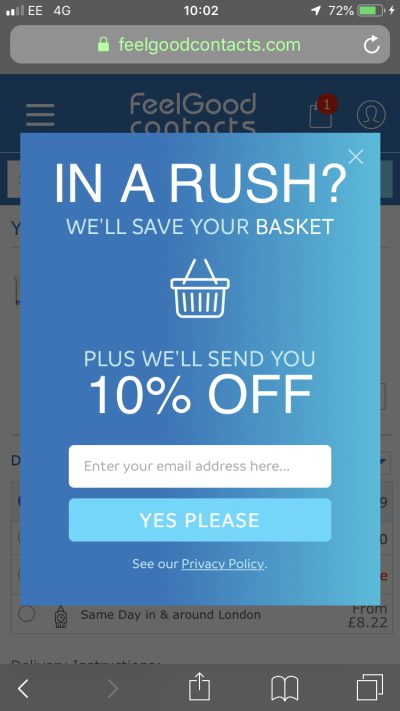
Of the shoppers who see this popover, one in three sign up. So the company has an opportunity to reach those customers who might have gone on to shop elsewhere.
That brings us to cart abandonment emails.
4. Send a cart abandonment email
Shopping abandonment emails are a type of triggered message. When a customer abandons a cart on your website, an email or email series is automatically triggered after a certain interval.
A common myth about cart abandonment is that remarketing emails will annoy the customer and push them to shop elsewhere.
On the contrary, shopping cart abandonment emails typically generate a sales uplift of 7-8%. That’s real money, and real customers who may otherwise have forgotten about your brand.
Why are cart abandonment alerts so effective? Most likely because they treat customers as individuals, sending them a message based on an action they’ve just taken.
Here’s what to keep in mind when setting up cart abandonment emails:
Identification
To reach shoppers with a cart abandonment email, you’ll need their email address. That’s why the higher your identification rate, the higher the sales uplift from shopping recovery emails.
Popovers are one of the best ways to increase your identification rate. We’ve already mentioned exit intent, but popovers can be used at many stages of the customer journey.
Once a shopper has been identified, you’ll need to make sure you can keep recognizing them, even if they haven’t logged in during the session. For instance, when someone clicks through on a marketing email or submits a form.
Timing
Best practice is to send a recovery email 30 minutes after the cart is abandoned. But you should test different timings to find out what works best for your customers.
If a shopper completes the purchase in the meantime, they should be automatically removed from the email program.
Content
The subject line should make it clear why the shopper received the email, and why they should open it. It’s a good idea to include the name of your brand, and even the name of the product.
Always include a recreation of the abandoned cart.
That means an image of the abandoned product, and relevant details such as price. Essentially, you need to remind the shopper what they liked, and provide enough information to help them make a buying decision.
Social proof, such as product star ratings, can also help reduce purchase hesitation.
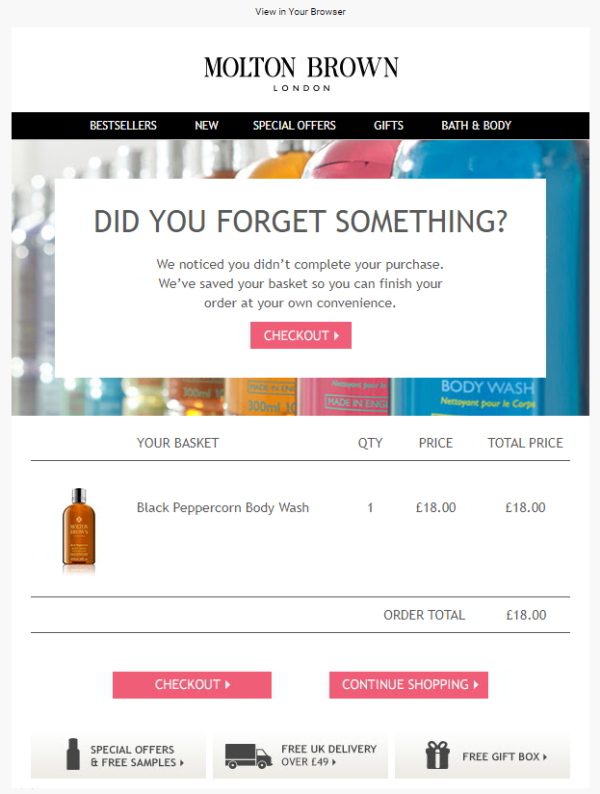
5. Send a cart abandonment email series
Sending a browse or cart abandonment email within 30 minutes is a no-brainer. You want to win back shoppers before the sale goes cold.
So why consider a second, or even third, reminder?
When you think about the way we shop, it makes a lot of sense.
Consumers lead busy lives, and frequently hop between multiple web pages, tabs and devices. Many shoppers use the cart as a wish list, or prefer to sleep on a purchase. Others are tied up doing something else when the 30-minute cart abandonment email comes in.
A well-timed second or third reminder could be what’s needed to bring these shoppers back to your website.
IronmongeryDirect introduced a multi-step program sending one message 30 minutes after abandonment, and another after 24 hours. At least 4% of their weekly sales revenues can be directly attributed to their abandonment activity.
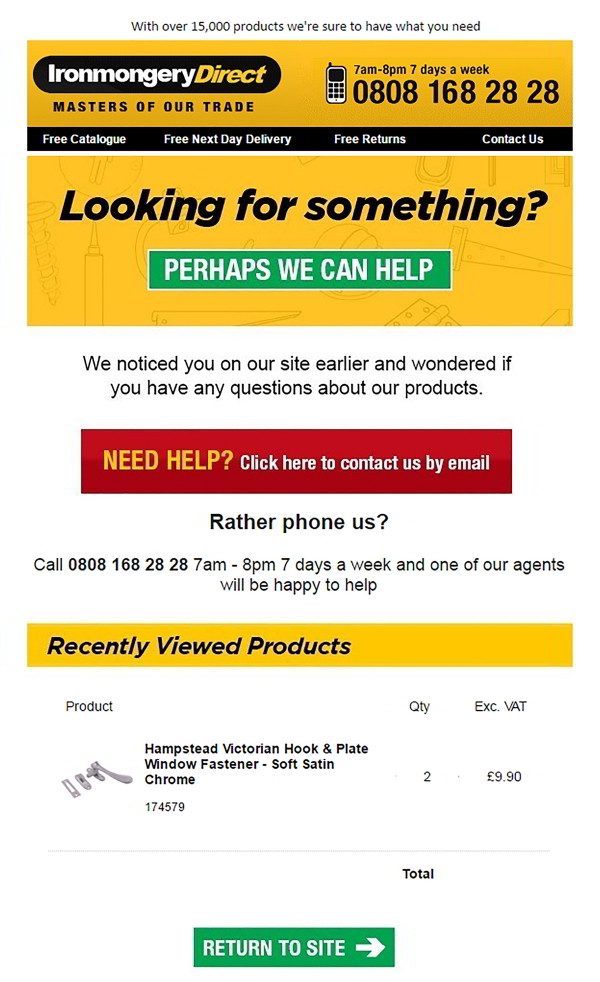
6. Use cart recovery incentives (in moderation)
Sometimes, shoppers abandon a cart because they’re put off by the price.
Discounts can be an efficient way to nudge these customers towards a conversion.
But there are downsides to incentivizing. It costs money, and may even devalue your brand. In some instances, consumers are trained to wait for a discount rather than paying full price.
You need to consider which shoppers will be attracted by incentives, and which shoppers can be won back with a simple abandonment email.
Research has shown that a serial cart abandoner is more likely to make a purchase after a remarketing campaign than a one-time abandoner. This suggests that offering incentives to serial abandoners might not be a good use of resources: a simple abandonment email could be enough to win them back.
Research shows that at certain price points – $100, $250, $400 and $500 – there’s an abandonment spike as customers have an emotional response to three-figure values. These abandoners are great candidates for incentives as you’ve got more room to play with when offering discounts.
7. Remarket via your website
When a customer returns to your website, you can use a banner or slide over to show them the product in their cart or wish list.
Here’s a slide over from Cottages.com, aiming to recover an abandoned booking:

Be smart about cart abandonment
If you’re selling online and have significant traffic, it’s likely that even basic cart recovery emails will generate a sales uplift.
But once you have a cart recovery solution in place, there are a few things you can consider to take emails to the next level.
- Use rules to treat customers differently based on their behavior, or the type of product they carted. For example, you might offer an incentive to win back a lapsed buyer, but send a simple recovery email to loyal customers.
- Use dynamic content such as countdown timers and popularity messaging to drive urgency and nudge customers towards a purchase.
- Experiment with product recommendations. For example, you might include similar products in case the carted item wasn’t quite right. Or you could include upsell items to increase the order value.
There’s no silver bullet when it comes to cart abandonment. The best approach will depend on your customers and the nature of your products.
But with a combination of the above methods, marketers have the power to recover lost sales, boost loyalty drive revenue.


